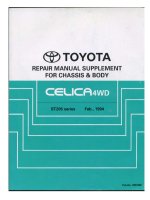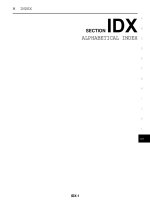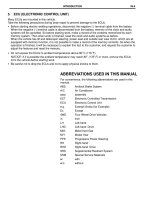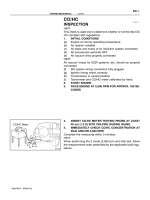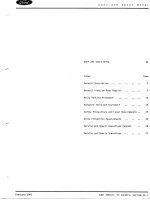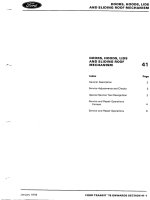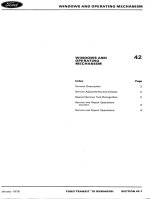Hitachi Zx470 hướng dẫn sửa chữa
Bạn đang xem bản rút gọn của tài liệu. Xem và tải ngay bản đầy đủ của tài liệu tại đây (29.51 MB, 878 trang )
PART NO.
ZX470-5G • 470LC-5G • 470H-5G • 470LCH-5G • 470R-5G • 470LCR-5G HYDRAULIC EXCAVATOR WORKSHOP MANUAL
URL:
WJAC-EN-00
Workshop Manual
ZX
470-5G
470LC-5G
470H-5G
470LCH-5G
470R-5G
470LCR-5G
Hydraulic Excavator
WJAC-EN-00
PRINTED IN JAPAN (K) 2012, 02
Service Manual consists of the following separate Part No.
Technical Manual (Operational Principle)
: Vol. No.TOJAC-EN
Technical Manual (Troubleshooting)
: Vol. No.TTJAC-EN
Workshop Manual
: Vol. No.WJAC-EN
INTRODUCTION
To The Reader
This manual is written for an experienced technician to
provide technical information needed to maintain and
repair this machine.
If you have any questions or comments, at if you found
any errors regarding the contents of this manual,
please contact using “Service Manual Revision Request
Form” at the end of this manual. (Note: Do not tear off
the form. Copy it for usage.):
Publications Marketing & Product Support Hitachi
Construction Machinery Co. Ltd.
TEL: 81-29-832-7084
FAX: 81-29-831-1162
E-mail:
Be sure to thoroughly read this manual for correct
product information and service procedures.
Additional References
Please refer to the other materials (operator’s manual,
parts catalog, engine technical material and Hitachi
training material etc.) in addition to this manual.
Manual Composition
Information included in the Workshop Manual:
Technical information needed for maintenance and
repair of the machine, tools and devices needed for
maintenance and repair, maintenance standards, and
removal / installation and assemble / disassemble
procedures.
This manual consists the Technical Manual, the Workshop
Manual and the Engine Manual.
Information included in the Technical Manual:
Technical information needed for redelivery and delivery,
operation and activation of all devices and systems,
operational performance tests, and troubleshooting
procedures.
Information included in the Engine Manual:
Technical information needed for redelivery and delivery
and maintenance and repair of the machine, operation
and activation of all devices and systems, troubleshooting
and assemble / disassemble procedures.
Page Number
Each page has a number, located on the center lower part
of the page, and each number contains the following
information:
Example:
Technical Manual: T 1-3-5
T
1
3
5
Workshop Manual: W 1-3-2-5
W
1
3
2
5
Technical Manual
Section Number
Group Number
Consecutive Page Number for Each Group
IN-01
Workshop Manual
Section Number
Group Number
Sub Group Number
Consecutive Page Number for Each Group
INTRODUCTION
Safety Alert Symbol and Headline Notations
In this manual, the following safety alert symbol and
signal words are used to alert the reader to the potential
for personal injury of machine damage.
d CAUTION:
Indicated potentially hazardous situation which could, if
not avoided, result in personal injury or death.
d This is the safety alert symbol. When you see this
IMPORTANT:
Indicates a situation which, if not conformed to the
instructions, could result in damage to the machine.
symbol, be alert to the potential for personal injury.
Never fail to follow the safety instructions prescribed
along with the safety alert symbol.
The safety alert symbol is also used to draw attention to
component/part weights.
To avoid injury and damage, be sure to use appropriate
lifting techniques and equipment when lifting heavy
parts.
f NOTE:
Indicates supplementary technical information or knowhow.
Units Used
Example: 24.5 MPa (250 kgf/cm2, 3560 psi)
SI Units (International System of Units) are used in this
manual. MKSA system units and English units are also
indicated in parentheses just behind SI units.
A table for conversion from SI units to other system units
is shown below for reference purposes.
Quantity
To Convert From
Into
Multiply By
Length
mm
in
0.03937
mm
ft
0.003281
L
US gal
0.2642
L
US qt
1.057
m3
yd3
1.308
Weight
kg
lb
2.205
Force
N
kgf
0.10197
N
lbf
0.2248
Torque
N·m
kgf·m
Pressure
MPa
kgf/cm
MPa
psi
145.0
kW
PS
1.360
kW
HP
1.341
Temperature
°C
°F
°C×1.8+32
Velocity
km/h
mph
0.6214
min
rpm
1.0
L/min
US gpm
0.2642
mL/rev
cc/rev
1.0
Volume
Power
Flow rate
-1
fNOTE:
The numerical value in this manual might be
different from the above-mentioned table.
IN-02
0.10197
2
10.197
SYMBOL AND ABBREVIATION
Symbol /
Abbreviation
TO
TT
T/M
W, W/M
MC
ECM
VGS
GSM
GPS
CAN
A/C
OP, OPT
MPDr.
A/I
WU
Li
ATT
HI, Hi
LO, Lo
Name
Explanation
Technical manual (Operational principle)
Technical manual (Troubleshooting)
Technical manual
Workshop manual
Technical manual (Operational Principle).
Technical manual (Troubleshooting).
Technical manual.
Workshop manual (Removal and Installation, Disassembly
and Assembly).
Main Controller
Main controller. MC controls the engine, pump, and valve
according to the machine operating condition.
Engine Control Module
Engine controller. ECM controls fuel injection amount
according to the machine operating condition.
Variable Geometry System controller
Variable turbo controller. VGS is an exhaust turbo charged
system to supercharge the exhaust energy while running
the engine at slow idle speed. VGS optimizes the turbine
rotation, improves the performance at slow-speed torque
and the acceleration, reduces fuel consumption, and reduces
particulate matter (PM) by adjusting the nozzle opening of
turbine housing.
Global System for Mobile communications Communication controller. GSM is a type of wireless
controller
communication system, is used in more than on 100
countries around Europe and Asia, and becomes the factual
global standards of the mobile telephone.
Global Positioning System
Global positioning system.
Controller Area Network
CAN communication. CAN is a serial communications
protocol internationally-standardized by ISO (International
Organization for Standardization).
Air Conditioner
Air conditioner.
Option
Optional component.
Maintenance Pro Dr.
MPDr. is software that troubleshooting, monitoring, and
adjustment.
Auto-Idle
Auto-idle.
Warming-Up
Warming-up.
Low (Slow) Idle
Slow idle engine speed.
Attachment
Attachment. Attachment is optional parts such as breaker,
crusher, and pulverizer in this manual.
High
Travel fast position.
Low
Travel slow position.
SY-1
SYMBOL AND ABBREVIATION
Symbol /
Name
Abbreviation
DPF
Diesel Particulate Filter
DPD
Diesel Particulate Diffuser
DOC
Diesel Oxidation Catalyst
CSF
Catalyzed Soot Filter
PM
EGR
Particulate Matter
Exhaust Gas Recirculation
Explanation
DPF is a filter which removes particulate matter (PM)
including the toxic substance of exhaust gas of the diesel
engine. Exhaust particulate removal equipment.
DPD is an exhaust emission control system, a type of DPF,
which cleans up particulate matter (PM) of diesel engine
exhaust gas. DPD is a ceramic filter which traps and filters
PM of exhaust gas. DPD burns up accumulated PM when PM
increases and regenerates the filter.
Oxidation catalyst for the diesel engine. Diesel oxidation
catalyst oxidizes unburnt fuel and raises exhaust
temperature.
Filter. The filter traps, burns, and remove particulate matter
(PM) by using high-temperature-exhaust gas with diesel
oxidation catalyst. Catalyst is applied onto the filter. This
advances PM burning.
Particulate matter.
The EGR control re-circulates a part of exhaust gas in the
intake manifold and combines it with intake-air. Therefore,
combustion temperature is lowered and generation of oxide
of nitrogen (NOx) is controlled.
SY-2
SAFETY
Recognize Safety Information
These are the SAFETY ALERT SYMBOLS.
When you see these symbols on your machine or in this
manual, be alert to the potential for personal injury.
Follow recommended precautions and safe operating
practices.
SA-688
Understand Signal Words
On machine safety signs, signal words designating the
degree or level of hazard - DANGER, WARNING, or CAUTION
- are used with the safety alert symbol.
DANGER indicates an imminently hazardous situation
which, if not avoided, will result in death or serious injury.
WARNING indicates a potentially hazardous situation
which, if not avoided, could result in death or serious
injury.
CAUTION indicates a potentially hazardous situation
which, if not avoided, may result in minor or moderate
injury.
DANGER or WARNING safety signs are located near
specific hazards. General precautions are listed on
CAUTION safety signs.
Some safety signs do not use any of the designated signal
words above after the safety alert symbol are occasionally
used on this machine.
CAUTION also calls attention to safety message in this
manual.
To avoid confusing machine protection with personal
safety messages, a signal word IMPORTANT indicates a
situation which, if not avoided, could result in damage to
the machine.
NOTE: indicates an additional explanation for an
element of information.
SA-1
SA-1223
SAFETY
Follow Safety Instructions
Carefully read and follow all safety signs on the machine
and all safety messages in the operator's manual.
Safety signs should be installed, maintained and replaced
when necessary.
If a safety sign or the operator's manual is damaged or
missing, order a replacement from your authorized dealer
in the same way you order other replacement parts (be
sure to state machine model and serial number when
ordering).
Learn how to operate the machine and its controls correctly
and safely.
Allow only trained, qualified, authorized personnel to
operate the machine.
Keep your machine in proper working condition.
Unauthorized modifications of the machine may impair
its function and/or safety and affect machine life.
Do not modify any machine parts without authorization.
Failure to do so may deteriorate the part safety, function,
and/or service life. In addition, personal accident,
machine trouble, and/or damage to material caused by
unauthorized modifications will void Hitachi Warranty
Policy.
Do not use attachments and/or optional parts or
equipment not authorized by Hitachi. Failure to do so
may deteriorate the safety, function, and/or service life
of the machine. In addition, personal accident, machine
trouble, and/or damage to material caused by using
unauthorized attachments and/or optional parts or
equipment will void Hitachi Warranty Policy.
The safety messages in this SAFETY chapter are intended
to illustrate basic safety procedures of machines. However
it is impossible for these safety messages to cover every
hazardous situation you may encounter. If you have any
questions, you should first consult your supervisor and/
or your authorized dealer before operating or performing
maintenance work on the machine.
SA-2
SA-003
SAFETY
Prepare for Emergencies
Be prepared if a fire starts or if an accident occurs.
Keep a first aid kit and fire extinguisher on hand.
Thoroughly read and understand the label attached on
the fire extinguisher to use it properly.
To ensure that a fire extinguisher can be always used
when necessary, check and service the fire extinguisher
at the recommended intervals as specified in the fire
extinguisher manual.
Establish emergency procedure guidelines to cope with
fires and accidents.
Keep emergency numbers for doctors, ambulance
service, hospital, and fire department posted near your
telephone.
SA-437
Wear Protective Clothing
Wear close fitting clothing and safety equipment
appropriate to the job.
You may need:
A hard hat
Safety shoes
Safety glasses, goggles, or face shield
Heavy gloves
Hearing protection
Reflective clothing
Wet weather gear
Respirator or filter mask.
Be sure to wear the correct equipment and clothing for the
job. Do not take any chances.
Avoid wearing loose clothing, jewelry, or other items that
can catch on control levers or other parts of the machine.
Operating equipment safely requires the full attention of
the operator. Do not wear radio or music headphones while
operating the machine.
SA-3
SA-438
SAFETY
Protect Against Noise
Prolonged exposure to loud noise can cause impairment or
loss of hearing.
Wear a suitable hearing protective device such as
earmuffs or earplugs to protect against objectionable or
uncomfortably loud noises.
SA-434
Inspect Machine
Inspect your machine carefully each day or shift by walking
around it before you start it to avoid personal injury.
In the walk-around inspection be sure to cover all points
described in the "Inspect Machine Daily Before Starting"
section in the operator’s manual.
SA-435
SA-4
SAFETY
General Precautions for Cab
Before entering the cab, thoroughly remove all dirt and/or
oil such as mud, grease, soil or stones that may mess up
the cab from the soles of your work boots. If any controls
such as a pedal is operated while with dirt and/or oil on
the soles of the operator’s work boots, the operator’s foot
may slip off the pedal, possibly resulting in a personal
accident.
Do not mess up around the operator's seat with parts,
tools, soil, stones, obstacles that may fold up or turn
over, cans or lunch box. The levers or pedals become
inoperable if obstacle jams in operation stroke of the
travel levers/pedals, pilot control shut-off lever or control
levers, which may result in serious injury or death.
Avoid storing transparent bottles in the cab. Do not
attach any transparent type window decorations on
the windowpanes as they may focus sunlight, possibly
starting a fire.
Refrain from listening to the radio, or using music
headphones or mobile telephones in the cab while
operating the machine.
Keep all flammable objects and/or explosives away from
the machine.
After using the ashtray, always cover it to extinguish the
match and/or tobacco.
Do not leave cigarette lighters in the cab. When the
temperature in the cab increases, the lighter may
explode.
Use proper floor mat dedicated to the machine. If another
floor mat is used, it may be displaced and contact with
the travel pedals during operation, resulting in serious
injury or death.
SA-5
SAFETY
Use Handholds and Steps
Falling is one of the major causes of personal injury.
When you get on and off the machine, always face the
machine and maintain a three-point contact with the
steps and handrails.
Do not use any controls as hand-holds.
Never jump on or off the machine. Never mount or
dismount a moving machine.
Be careful of slippery conditions on platforms, steps, and
handrails when leaving the machine.
Never get on and off the machine with tools in your
hands.
SA-439
Adjust the Operator's Seat
A poorly adjusted seat for either the operator or for the
work at hand may quickly fatigue the operator leading to
misoperations.
The seat should be adjusted whenever changing the
operator for the machine.
The operator should be able to fully depress the pedals
and to correctly operate the control levers with his back
against the seat back.
If not, move the seat forward or backward, and check
again.
Adjust the rear view mirror position so that the best rear
visibility is obtained from the operator’s seat. If the mirror
is broken, immediately replace it with a new one.
SA-6
SA-378
SAFETY
Ensure Safety Before Rising from or Leaving
Operator’s Seat
Before rising from the operator’s seat to open/close either
side window or to adjust the seat position, be sure to first
lower the front attachment to the ground and then move
the pilot control shut-off lever to the LOCK position. Failure
to do so may allow the machine to unexpectedly move
when a body part unintentionally comes in contact with
a control lever and/or pedal, possibly resulting in serious
personal injury or death.
Before leaving the machine, be sure to first lower the front
attachment to the ground and then move the pilot control
shut-off lever to the LOCK position. Turn the key switch OFF
to stop the engine.
Before leaving the machine, close all windows, doors, and
access covers and lock them up.
Fasten Your Seat Belt
If the machine should overturn, the operator may become
injured and/or thrown from the cab. Additionally the
operator may be crushed by the overturning machine,
resulting in serious injury or death.
Prior to operating the machine, thoroughly examine
webbing, buckle and attaching hardware. If any item is
damaged or worn, replace the seat belt or component
before operating the machine.
Be sure to remain seated with the seat belt securely
fastened at all times when the machine is in operation to
minimize the chance of injury from an accident.
We recommend that the seat belt be replaced every three
years regardless of its apparent condition.
SA-7
SA-237
SAFETY
Move and Operate Machine Safely
Bystanders can be run over.
Take extra care not to run over bystanders. Confirm the
location of bystanders before moving, swinging, or
operating the machine.
Always keep the travel alarm and horn in working
condition (if equipped). It warns people when the
machine starts to move.
Use a signal person when moving, swinging, or operating
the machine in congested areas. Coordinate hand signals
before starting the machine.
Use appropriate illumination. Check that all lights are
operable before operating the machine. If any faulty
illumination is present, immediately repair it.
Ensure the cab door, windows, doors and covers are
securely locked.
Check the mirrors and the monitor in the CAB for
problems.
If there is, replace the problem part(s) or clean the mirror,
camera and the monitor.
Refer to Rear View Monitor section on the cleaning of the
camera and the monitor in the operator's manual.
SA-426
Operate Only from Operator's Seat
Inappropriate engine starting procedures may cause the
machine to runaway, possibly resulting in serious injury or
death.
Start the engine only when seated in the operator's seat.
NEVER start the engine while standing on the track or on
ground.
Do not start engine by shorting across starter terminals.
Before starting the engine, confirm that all control levers
are in neutral.
Before starting the engine, confirm the safety around the
machine and sound the horn to alert bystanders.
SA-8
SA-444
SAFETY
Jump Starting
Battery gas can explode, resulting in serious injury.
If the engine must be jump started, be sure to follow
the instructions shown in the “OPERATING THE ENGINE”
chapter in the operator’s manual.
The operator must be in the operator’s seat so that the
machine will be under control when the engine starts.
Jump starting is a two-person operation.
Never use a frozen battery.
Failure to follow correct jump starting procedures could
result in a battery explosion or a runaway machine.
SA-032
Keep Riders off Machine
Riders on machine are subject to injury such as being struck
by foreign objects and being thrown off the machine.
Only the operator should be on the machine. Keep riders
off.
Riders also obstruct the operator’s view, resulting in the
machine being operated in an unsafe manner.
SA-379
SA-9
SAFETY
Precautions for Operations
Investigate the work site before starting operations.
Be sure to wear close fitting clothing and safety
equipment appropriate for the job, such as a hard hat,
etc. when operating the machine.
Clear all persons and obstacles from area of operation and
machine movement.
Always beware of the surroundings while operating.
When working in a small area surrounded by obstacles,
take care not to hit the upperstructure against obstacles.
When loading onto trucks, bring the bucket over the truck
beds from the rear side. Take care not to swing the bucket
over the cab or over any person.
M178-05-007
SA-10
SAFETY
Investigate Job Site Beforehand
When working at the edge of an excavation or on a road
shoulder, the machine could tip over, possibly resulting in
serious injury or death.
Investigate the configuration and ground conditions of
the job site beforehand to prevent the machine from
falling and to prevent the ground, stockpiles or banks
from collapsing.
Make a work plan. Use machines appropriate to the work
and job site.
Reinforce ground, edges and road shoulders as
necessary. Keep the machine well back from the edges of
excavations and road shoulders.
When working on an incline or on a road shoulder,
employ a signal person as required.
Confirm that your machine is equipped with a FOPS cab
before working in areas where the possibility of falling
stones or debris exist.
When the footing is weak, reinforce the ground before
starting work.
When working on frozen ground, be extremely alert. As
ambient temperatures rise, footing becomes loose and
slippery.
Beware the possibility of fire when operating the machine
near flammable objects such as dry grass.
SA-11
SA-380
SAFETY
Make sure the worksite has sufficient strength to firmly
support the machine.
When working close to an excavation or at road
shoulders, operate the machine with the tracks positioned
perpendicular to the cliff face with travel motors at the rear,
so that the machine can more easily evacuate if the cliff face
collapses.
If working on the bottom of a cliff or a high bank is required,
be sure to investigate the area first and confirm that no
danger of the cliff or bank collapsing exists. If any possibility
of cliff or bank collapsing exists, do not work on the area.
Soft ground may collapse when operating the machine on
it, possibly causing the machine to tip over. When working
on soft ground is required, be sure to reinforce the ground
first using large pieces of steel plates strong and firm
enough to easily support the machine.
Note that there is always a possibility of machine tipping
over when working on rough terrain or on slopes. Prevent
machine tipping over from occurring. When operating on
rough terrain or on slopes:
Reduce the engine speed.
Select slow travel speed mode.
Operate the machine slowly and be cautious with
machine movements.
M104-05-016
Install OPG Guard
In case the machine is operated in areas where the possibilities
of falling stones or debris exist, equip Hitachi OPG guard.
Consult your authorized dealer for installing the OPG guard.
The guard can be compliant with ROPS standards depending
on the machine specifications.
In order not to impair operator protective structure:
Replace damaged ROPS or OPG guard. Never attempt to repair
or modify the guard.
ROPS: Roll Over Protective Structure
OPG: Operator Protective Guard
SA-490
SA-12
SAFETY
Provide Signals for Jobs Involving Multiple
Machines
For jobs involving multiple machines, provide signals
commonly known by all personnel involved. Also, appoint
a signal person to coordinate the job site. Make sure that all
personnel obey the signal person’s directions.
SA-481
Confirm Direction of Machine to Be Driven
Incorrect travel pedal/lever operation may result in serious
injury or death.
Before driving the machine, confirm the position of the
undercarriage in relation to the operator’s position. If the
travel motors are located in front of the cab, the machine
will move in reverse when travel pedals/levers are
operated to the front.
SA-491
SA-13
SAFETY
Drive Machine Safely
Before driving the machine, always confirm that the travel
levers/pedals direction corresponds to the direction you
wish to drive.
Be sure to detour around any obstructions.
Avoid traveling over obstructions. Soil, fragments of rocks,
and/or metal pieces may scatter around the machine. Do
not allow personnel to stay around the machine while
traveling.
A
SA-657
Driving on a slope may cause the machine to slip or
overturn, possibly resulting in serious injury or death.
Never attempt to ascend or descend 35 degrees or
steeper slopes.
Be sure to fasten the seat belt.
When driving up or down a slope, keep the bucket facing
the direction of travel, approximately 0.2 to 0.3 m (A)
above the ground.
If the machine starts to skid or becomes unstable,
immediately lower the bucket to the ground and stop.
Driving across the face of a slope or steering on a
slope may cause the machine to skid or turnover. If
the direction must be changed, move the machine to
level ground, then, change the direction to ensure safe
operation.
A
SA-658
SA-441
WRONG
SA-590
SA-14
SAFETY
Avoid swinging the upperstructure on slopes. Never
attempt to swing the upperstructure downhill. The
machine may tip over. If swinging uphill is unavoidable,
carefully operate the upperstructure and boom at slow
speed.
If the engine stalls on a slope, immediately lower the
bucket to the ground. Return the control levers to neutral.
Then, restart the engine.
Be sure to thoroughly warm up the machine before
ascending steep slopes. If hydraulic oil has not warmed
up sufficiently, sufficient performance may not be
obtained.
Use a signal person when moving, swinging or operating
the machine in congested areas. Coordinate hand signals
before starting the machine.
Before moving machine, determine which way to move
travel pedals/levers for the direction you want to go.
When the travel motors are in the rear, pushing down
on the front of the travel pedals or pushing the levers
forward moves the machine forward, towards the idlers.
An arrow-mark seal is stuck on the inside surface of the
side frame to indicate the machine front direction.
Select a travel route that is as flat as possible. Steer the
machine as straight as possible, making small gradual
changes in direction.
Before traveling on them, check the strengths of bridges
and road shoulders, and reinforce if necessary.
Use wood plates in order not to damage the road surface.
Be careful of steering when operating on asphalt roads in
summer.
When crossing train tracks, use wood plates in order not
to damage them.
Do not make contact with electric wires or bridges.
When crossing a river, measure the depth of the river
using the bucket, and cross slowly. Do not cross the river
when the depth of the river is deeper than the upper
edge of the upper roller.
When traveling on rough terrain, reduce engine speed.
Select slow travel speed. Slower speed will reduce
possible damage to the machine.
Avoid operations that may damage the track and
undercarriage components.
During freezing weather, always clean snow and ice from
track shoes before loading and unloading machine, to
prevent the machine from slipping.
SA-15
Travel Motor
M104-05-008
Arrow -mark
M178-03-001
SA-011
SAFETY
Avoid Injury from Rollaway Accidents
Death or serious injury may result if you attempt to mount
or stop a moving machine.
To avoid rollaways:
Select level ground when possible to park the machine.
Do not park the machine on a grade.
Lower the bucket and/or other work tools to the ground.
Turn the auto-idle switch OFF and the power mode switch
ECO.
Run the engine at slow idle speed without load for 5
minutes to cool down the engine.
Stop the engine and remove the key from the key switch.
Pull the pilot control shut-off lever to LOCK position.
Block both tracks and lower the bucket to the ground.
Thrust the bucket teeth into the ground if you must park
on a grade.
Position the machine to prevent rolling.
Park at a reasonable distance from other machines.
SA-391
SA-2273
SA-16
SAFETY
Avoid Injury from Back-Over and Swing
Accidents
If any person is present near the machine when backing or
swinging the upperstructure, the machine may hit or run
over that person, resulting in serious injury or death.
To avoid back-over and swing accidents:
Always look around BEFORE YOU BACK UP AND SWING
THE MACHINE. BE SURE THAT ALL BYSTANDERS ARE
CLEAR.
Keep the travel alarm in working condition (if equipped).
ALWAYS BE ALERT FOR BYSTANDERS MOVING INTO THE
WORK AREA. USE THE HORN OR OTHER SIGNAL TO WARN
BYSTANDERS BEFORE MOVING MACHINE.
USE A SIGNAL PERSON WHEN BACKING UP IF YOUR VIEW
IS OBSTRUCTED. ALWAYS KEEP THE SIGNAL PERSON IN
VIEW.
Use hand signals, which conform to your local regulations,
when work conditions require a signal person.
No machine motions shall be made unless signals are
clearly understood by both signalman and operator.
Learn the meanings of all flags, signs, and markings used
on the job and confirm who has the responsibility for
signaling.
Keep windows, mirrors, and lights clean and in good
condition.
Dust, heavy rain, fog, etc., can reduce visibility. As visibility
decreases, reduce speed and use proper lighting.
Read and understand all operating instructions in the
operator’s manual.
SA-17
SA-383
SA-384
SAFETY
Keep Person Clear from Working Area
A person may be hit severely by the swinging front
attachment or counterweight and/or may be crushed
against an other object, resulting in serious injury or death.
Keep all persons clear from the area of operation and
machine movement.
Before operating the machine, set up barriers to the
sides and rear area of the bucket swing radius to prevent
anyone from entering the work area.
SA-386
Never Position Bucket Over Anyone
Never lift, move, or swing bucket above anyone or a truck
cab.
Serious injury or machine damage may result due to bucket
load spill or due to collision with the bucket.
SA-487
SA-18
SAFETY
Avoid Undercutting
In order to retreat from the edge of an excavation if the
footing should collapse, always position the undercarriage
perpendicular to the edge of the excavation with the travel
motors at the rear.
If the footing starts to collapse and if retreat is not
possible, do not panic. Often, the machine can be secured
by lowering the front attachment, in such cases.
SA-488
Avoid Tipping
DO NOT ATTEMPT TO JUMP CLEAR OF TIPPING MACHINE
--- SERIOUS OR FATAL CRUSHING INJURIES WILL RESULT
MACHINE WILL TIP OVER FASTER THAN YOU CAN JUMP
FREE
FASTEN YOUR SEAT BELT
The danger of tipping is always present when operating on
a grade, possibly resulting in serious injury or death.
To avoid tipping:
Be extra careful before operating on a grade.
Prepare machine operating area flat.
Keep the bucket low to the ground and close to the
machine.
Reduce operating speeds to avoid tipping or slipping.
Avoid changing direction when traveling on grades.
NEVER attempt to travel across a grade steeper than 15
degrees if crossing the grade is unavoidable.
Reduce swing speed as necessary when swinging loads.
SA-012
Be careful when working on frozen ground.
Temperature increases will cause the ground to become
soft and make ground travel unstable.
SA-440
SA-19
